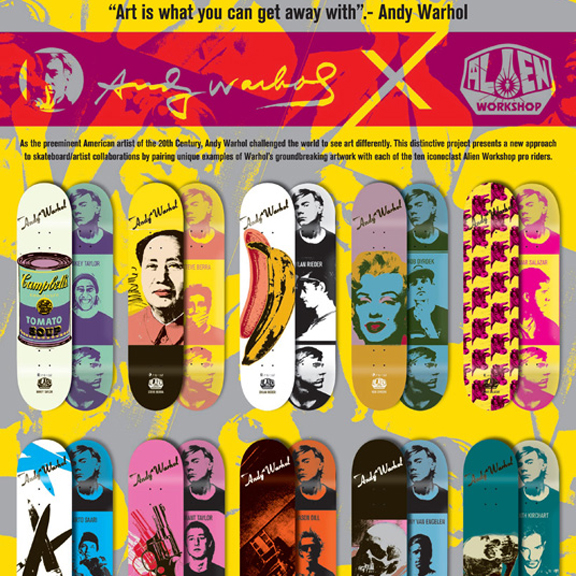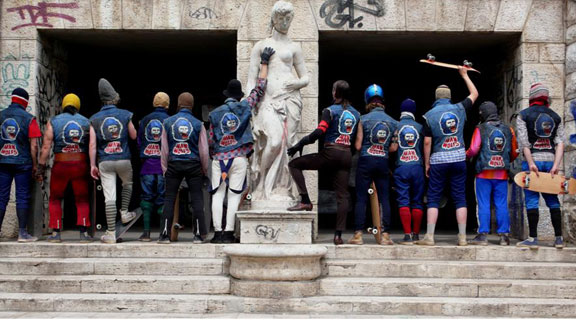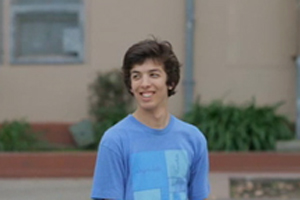
LakaiWelcome aboard Daniel!
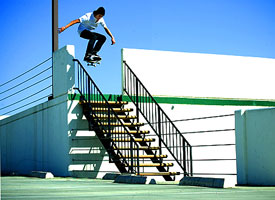
Ben Karpinski
This year's OIAM was the obvious choice. Tom Karangelov nollies into the future.
Corey Adams and Alex Craig are the co-writers and directors of the new film, "Machotaildrop" (trailer below). The film, which features pro skaters Rick McCrank, John Rattray and Steve Olson among others, explores the dreams of skating sponsorship and stardom in a fanciful realm. Adams, who grew up in Canada and Craig, who grew up in Scotland, became friends through their shared loves of skateboarding and filmmaking over 10 years ago. They gained shred recognition when they won the Fuel Experiment with their short film, "Harvey Spannos." The reward for winning the competition was a $1,000,000 budget to make a feature film. That film, "Machotaildrop," is now complete and currently making the film festival rounds with early accolades being heaped on the project and it's co-creators. I spoke with Adams and Craig to talk about how they made a film about skating that rings true to skaters by ignoring the obvious and embracing the bizarre.
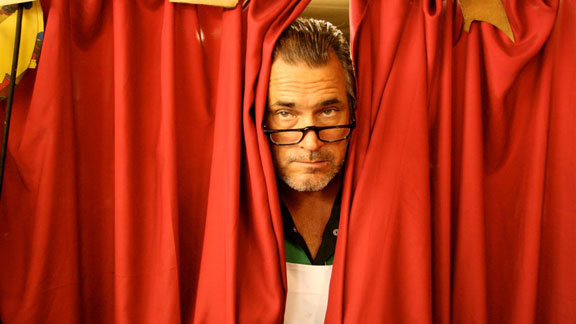 Courtesy of "Machotaildrop"The legendary Steve Olson plays the character "George" in the film.
Courtesy of "Machotaildrop"The legendary Steve Olson plays the character "George" in the film.Alex: These Canadian guys turned up in Scotland and we got on really well. They were telling me about their friend Corey who made films, which was also what I was doing. His friends and I ended up sending videos to each other between Scotland and Canada for maybe two years before I'd even met Corey. And then in 1999, I got the opportunity to come over to Vancouver on a road trip and I met Corey at that point and we hit it off. We've been making film projects together ever since.
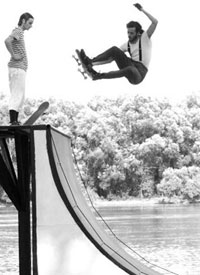
Courtesy of "Machotaildrop"Rick McCrank plays the character, "Blair Stanley" in the film.
Alex: No, our first project together is another funny story. In 2002, I came to Vancouver and Corey and I were going to go on a road trip and make a film about karaoke bars in the Midwest. But just before I arrived, Corey had gone skating. He was skating a big bowl and some kid dropped in on him and collided with him and snapped Corey's jaw in two places. So I get off the plane and this stranger comes and meets me and tells me Corey's in the hospital. I go to the hospital and Corey's in bed with his whole face wired shut. He couldn't open his mouth at all, couldn't speak and had to eat all his food pulverized through a straw. So, obviously, we couldn't go on the road trip. So we decided to make a film based on things we found in Corey's house. We found a mask of a werewolf and a fake leg. We ended up making a 100% improvised film called "Of Wolf And Limb." Keegan Sauder is in it and Quinn Starr is also in it.
When you two started to make movies, were you trying to make careers in filmmaking or was it just for fun?
Alex: Purely for fun. I guess in the back of our minds, that was always a dream for us. But mostly we were just having a laugh and doing what we wanted to do. At that point Corey was working on special effects in Vancouver and I was working on a TV program in Scotland. Both of our jobs were pretty limiting. It wasn't what we really wanted to do. It was almost a relief from our jobs to do what we wanted to do and make things for pure inspiration.
Corey: I'd been making stuff since I was kid, just skate videos and filming dumb s**t all the time. Then I started working as a special effects makeup artist and I did that for a bunch of years. The last thing I worked on was "Freddy vs. Jason." Seeing the industry that close made it seem like it was possible to make my own stuff and get it out on a more professional level, I guess.
How did "Harvey Spannos" come about and how it ended up on FuelTV?
Alex: A few years later I was back in Vancouver and Corey and I were working together making a series of short films about hillbillies called, "Swamp Donkey." And a friend of Corey's was telling us about the Fuel Experiment. We decided we should both submit proposals and see what happens. I actually went back to Scotland and was way too busy and didn't get around to it. But Corey wrote out the treatment for Harvey Spannos, submitted it and his proposal was chosen as one of the ten films to receive funding. So I came back the following summer in 2005 and the two of us worked on "Harvey Spannos" for about four months, intensively. While we were making it, we really thought our film was going to get laughed out of the competition because it wasn't the obvious road or the standard way of filmmaking. But it ended up winning the competition and Fuel was generous enough to award us the $1,000,000 budget to go on and make "Machotaildrop."
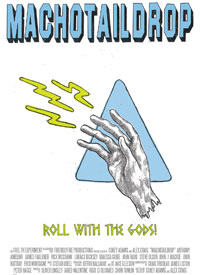
Courtesy of "Machotaildrop"The film poster.
Alex: Yeaaah. It was never our intention to do it like that. But, as we started to develop the script to "Machotaildrop," it just sort of became like that. There are a few discrepancies. In "Harvey Spannos" Blair Stanley lives in a huge castle and in "Machotaildrop," he lives within the Machotaildrop underground compound.
Corey: We've said "Machotaildrop takes place about 10 years after "Harvey Spannos."
Where did the inspiration for "Machotaildrop" come from?
Corey: I think it was something that every skater can relate to. When you're a child the whole dream is to get sponsored by one of these companies. Every kid is working on this magical footage tape.
One of the things I really like about "Harvey Spannos" and "Machotaildrop," is you've made a movie that incorporates skating and avoided the clichés and pitfalls of other attempts at skate movies by going for the surreal. Was that a conscious decision in approaching film?
Alex: That was very much our idea. We knew there was no way we could portray skateboarding in a serious manner. I was always our idea that we would go in the opposite direction and make it fantasy and farcical. We always knew what we shouldn't do.
Corey: When you look at those other films, it's so obvious why they fail. They try to take skateboarding and capture the essence in a literal way. That's never going to work through the medium of film. You might be able to do it with poetry or something. That's why we decided to take another approach and make it take place in a fantasy world. When you take something and put it in a strange place, the true qualities shine through.
You do, however, pay some homage to "Thrashin" with the skate gang, "Manwolfs" in the film and the cameo of Steve Olson.
Alex: "Thrashin," because of our age (Alex is 36. Corey is 35) is quite special. Maybe one day "Street Dreams" will be like that for future generations.
The danger and allure of brand identity and the way that can taint the purity of skateboarding seems to be a theme in "Machotaildrop." What made you both hone in on that?
Alex: I think it's the age-old story of the purity of essence. Once you strip back the nonsense that's involved in anything you can get it's real essence and that's where the fun is. It's not like we're having a real go at any of the companies involved in skateboarding. It's more just to have a laugh about skateboarding, at the end of the day, being about enjoying yourself and doing what you want to do with your life.
Corey: When you're young, you don't think that when skateboarding becomes a job for these guys it changes completely. Some of the people that I know that are professionals now, there's pressure. There's times when you don't want to skate but you're sitting at a railing with filmers and photographers. You start to think, "Is this what I signed up for?" But it is what you signed up for.
What were your film influences in the writing process?
Alex: "Charlie and the Chocolate Factory" was always talked about during production. It definitely became an inspiration. For me and Corey, I would say a Clockwork Orange was an inspiration and the early films of Werner Hertzog and the Hungarian director, Bela Tarr and his film "Werckmeister harmóniák" was a huge inspiration; it's one of the reasons we went to Eastern Europe to shoot the movie.
Corey: Guys like Terry Gilliam and Michelle Gondry. We were trying to draw influence from films that were as far removed from action sports as possible. We'd watch those and say, "How would a director like this approach a topic like skateboarding?"
How did John Rattray and Rick McCrank and Steve Olson get involved with the film?
Alex: Rattray and I grew up together in Scotland. McCrank has been living in Vancouver for 10 years or so and Corey's known him for a while. They're both good friends of ours that we have a tremendous respect for, their skateboarding especially. When we started, even with "Harvey Spannos," we were adamant that we didn't want to use stunt doubles. We always thought they have to be real skateboarders. When we were developing characters for "Machotaildrop" Rattray and McCrank were obvious choices; we knew them so well, had worked with them in the past, and their skateboarding speaks for itself.
With Steve Olson, we had this character, "George" and a short list of people we would like to see play it. Olson, Neil Blender and The Gonz were on that list. Blender and The Gonz were impossible to get a hold of. McCrank is friends and teammates with Steve's son, Alex Olson. We got McCrank to speak to Alex and Alex to speak to Steve. He accepted the role less than a week before we had to film his scenes.
Corey: We thought, if we get these guys and get their blessing and they're willing to be a part of it, then the skate industry is going to take what we're doing more seriously. Having Rattray and McCrank in the film boosts our credibility. They're basically backing what we're saying.
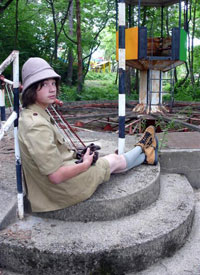
Courtesy of "Machotaildrop"Anthony Amedori as "Walter Rhum" on location for the film.
Corey: We didn't want a kid that was too well known. But we got him within a week before we needed him for scenes, basically sight unseen. It was nerve racking.
Alex: All of Walter Rhum's skating is really Anthony Amedori. There's no fake skating or stunt doubles in the film. We were having real trouble finding the right person that had the look, could act the roll and could really skate. We exhausted all of our resources in Vancouver and Scotland without coming up with anyone so the folks at Fuel put out some feelers in Los Angeles and they came up with Anthony. We were already in preproduction in Hungary. The Fuel folks were sending screen test clips to us and they came up with Amedori. He seemed absolutely right for the part, skated amazingly. We gave him a call from Hungary and offered him the job over the telephone without ever meeting him. He flew over within a week and began working with us.
Are there skate videos that have been an influence on you're film?
Alex: Well, the name of the film is a direct link. In the old G&S video, "Footage" Neil Blender is standing on top of a big fence and says, "This is called 'macho taildrop.' When girls come around, this is what you want to do to get 'em." So that's obviously a direct link. I was also hugely influenced by the first Alien Workshop video "Memory Screen." That's why I wanted film Super 8.
What's the one thing you'd like kids to take away from seeing the film?
Corey: I think just to appreciate skateboarding for skateboarding itself. Don't focus so much on the corporate end of it. It seems like nowadays every kid wants to be a star and wants to be famous. And it's like, Do you really want that? Do you know what that entails?
So how and when can people see the film?
Alex: The film is doing the festival circuit right now. We premiered it at the Toronto Film Festival. It played at the Whistler Film Festival and it's playing at the X Dance Film Festival in Salt Lake City. We're applying to more festivals. That's the main outlet for he next few months and we'll go from there.

Joe Hammeke
Want the Boss frontside flipping in your town on Go Skateboarding Day? Tell the Emerica homies to hook it up.
In what may just be the coolest collaborative effort to hit skateboarding ever, Alien Workshop has teamed up with The Andy Warhol Foundation for the Visual Arts, Inc. to put out an incredible limited-edition series of decks. These boards combine Warhol's iconic imagery with each of Alien Workshop's 10 pro riders. The continuing creative push of Alien Workshop and their entire brand aesthetic blends perfectly with Warhol's memorable imagery. Five decks in the series feature art from Warhol's famed Death & Disaster series and five decks feature iconic Warhol pop art works. Dylan Rieder, for example, gets the famed "Banana" image and Mikey Taylor's board features Warhol's iconic Campbell Soup imagery. The performing art executed by the skaters riding these decks will be well complimented by the art beneath their feet.
